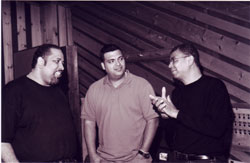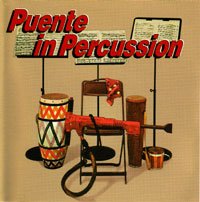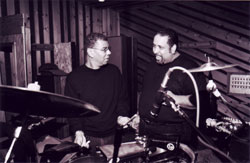

|
Soundclip:
|
| See Steve's Hand-Written Lead
Sheet |
|
Steve
Khan's
lead
sheet :  If you are familiar with Tito Puente's classic recording, "PUENTE IN PERCUSSION" from 1957, which featured: Tito;
Willie Bobo; Mongo Santamaria; "Patato" Valdés; and bassist, Bobby Rodríguez, you would remember the opening track, the percussion descarga entitled "Tito on Timbales." It is, in essence, a bass tumbao over which each percussionist is given a chance to stretch-out and express himself. Those solos are sandwiched around a little unison "break" figure. So, understanding this concept, and with all due reverance, I said to myself: "Geez, I can write a bass line and a little break figure. So? Why not do it?" And so, I wrote what you can now hear. Of course, the results of the finished take were a most joyous surprise for me and all those involved. It was truly a rhythmic "lovefest" of some sort. Smiles and laughter abounded everywhere.
If you are familiar with Tito Puente's classic recording, "PUENTE IN PERCUSSION" from 1957, which featured: Tito;
Willie Bobo; Mongo Santamaria; "Patato" Valdés; and bassist, Bobby Rodríguez, you would remember the opening track, the percussion descarga entitled "Tito on Timbales." It is, in essence, a bass tumbao over which each percussionist is given a chance to stretch-out and express himself. Those solos are sandwiched around a little unison "break" figure. So, understanding this concept, and with all due reverance, I said to myself: "Geez, I can write a bass line and a little break figure. So? Why not do it?" And so, I wrote what you can now hear. Of course, the results of the finished take were a most joyous surprise for me and all those involved. It was truly a rhythmic "lovefest" of some sort. Smiles and laughter abounded everywhere.Like Tito's original, "Cosecha lo que has sembrado" begins with John Patitucci's huge sounding bass tumbao at letter [I]. He is joined by Roberto Quintero's güiro before Ralph Irizarry's funky avanico brings us all in. My little guitar montuno at [A] was supposed to have been played for 8 bars prior to the first "break" figure, but, for some reason, while listening back to our only take, Roberto thought it best that it only be for 4 bars.  And so, that's what you now hear on the recording. I have written the lead sheet to better express what my original concepts were. And, if I was to play this live, this is how it would be done! What was so funny about everything was that at the rehearsal, and during the 'talk through' at the session, I told everyone, and VERY clearly in both English and Spanish, that after each "break figure" at [A2], they were to leave 8 bars for my montuno BEFORE they began to solo. Well, I don't know what happened but, right after each break figure, Roberto, Ralphy, and Jack just started bashing and banging away, as if I had said nothing. Ay qué falta de respeto! All I could do was laugh, because their enthusiasm for playing was too contagious. However, stubborn character that I am, I just held the form together, just as I had conceived of it. And that's what you hear forever and always on the recording. And so, that's what you now hear on the recording. I have written the lead sheet to better express what my original concepts were. And, if I was to play this live, this is how it would be done! What was so funny about everything was that at the rehearsal, and during the 'talk through' at the session, I told everyone, and VERY clearly in both English and Spanish, that after each "break figure" at [A2], they were to leave 8 bars for my montuno BEFORE they began to solo. Well, I don't know what happened but, right after each break figure, Roberto, Ralphy, and Jack just started bashing and banging away, as if I had said nothing. Ay qué falta de respeto! All I could do was laugh, because their enthusiasm for playing was too contagious. However, stubborn character that I am, I just held the form together, just as I had conceived of it. And that's what you hear forever and always on the recording.I think that it is probably worth taking a moment discuss my choices of chord spellings during the [A2] "break" sections. As the harmony modulates via the usage of common-tone top voices, I decided to label the chord in bar 3 as Cb/Db instead of calling it B/C#. I suppose that my reasoning involved the fact that, during the C7(#9) chord, I had used both a Bb and, an Eb in the top voice, so I felt that it was best to show that the Eb remained on top as the Cb/Db chord arrived. I did this for the guitar, even though, in John Patitucci's bass part I used a C#, keeping the bass consistent. However, as the F#7(9b5) appears, I returned to using #'s which is more consistent with the fact that we are and have been in an E dominant 7th area. But, in sharp contrast to that, I returned b's again when the Eb7(#9) appears. To tell you the truth, I'm really even certain what the 'official' rules are for spelling chords correctly. So, I simply try to write things out in the manner in which I feel will communicate best to the players. That directive is my only guiding principle. I have to admit that one of my favorite memories of the 2nd day of recording was watching Ralphy, Roberto, and Jack interact together personally and musically. They just seemed to have the best time together. Jack was totally fascinated by Ralph's style and virtuosity. And, fortunately, photographer Richard Laird captured some of that empathy and respect in his photos. After Roberto's conga solo, the first time [B2] arrives, Ralphy came roaring in with a magnificent timbales solo. And, for the record, since then, everyone who has heard it, completely flips!!! After Ralph was done, and we had negotiated the break figure again, I had no idea just what Jack was going come up with, but, as you'll hear on the CD, he just seemed to be so inspired, by what Ralphy had played, that he unleashed some of his most funky and musical soloing of the sessions. It was remarkable, and I still smile broadly each time I hear this track.  So, by this time, one might be wondering, "Well, is the guitar ever going to do something on this tune?" Of course! As a further tribute to Tito Puente's brilliant recording, I had always planned on creating a double-time section which, in concept, would be something like "Four Beat Mambo." And so, after Jack's fantastic solo, we play [A2] one last time, but this time, we take the 2nd Ending, and, at [C], John sets-up the double-time tumbao as we move into 3:2 rumba clave. It had always been my idea to treat this section not so much as a traditional solo but to have it be more of a vehicle for my Korg DVP-1 Harmonizer-induced psychedelic big band. Had it not been for the special footswitch, designed by Ralph Skelton[Pacific Innovative Electronics], I never would have been able to have played like this live!!! It was really fun. One little side note, when we recorded this, and I came in with the little figure you see at [C], the first two times I played it, I played it as two quarter notes, and not what you now see and hear on the recording. Somehow, by a growing instinct, I knew, I felt that I was out-of-clave and switched the figure for times 3 and 4. That was a good sign for my progress in Latin music. But, it wasn't until I was doing some digital editing with Rob Mounsey afterwards, that I replaced the four "out-of-clave" bars with the correct figures. Rob looked at me as if I was nuts. But, I told him, we have to do what's correct. Again, serve the music!!! Use the technology to do that if you must!!! I also have to point out that, at around the 6:10 mark of the piece, when Ralph Irizarry switches from his "jam block" to the Salsa bell, and begins to play[what he described as] Puerto Rico's "Bomba" rhythm, everything just takes off and arrives at another level. In its way, for me, from that point forward, these are the heaviest swingin' moments on the recording!!! Vaya Ralphy!!!
So, by this time, one might be wondering, "Well, is the guitar ever going to do something on this tune?" Of course! As a further tribute to Tito Puente's brilliant recording, I had always planned on creating a double-time section which, in concept, would be something like "Four Beat Mambo." And so, after Jack's fantastic solo, we play [A2] one last time, but this time, we take the 2nd Ending, and, at [C], John sets-up the double-time tumbao as we move into 3:2 rumba clave. It had always been my idea to treat this section not so much as a traditional solo but to have it be more of a vehicle for my Korg DVP-1 Harmonizer-induced psychedelic big band. Had it not been for the special footswitch, designed by Ralph Skelton[Pacific Innovative Electronics], I never would have been able to have played like this live!!! It was really fun. One little side note, when we recorded this, and I came in with the little figure you see at [C], the first two times I played it, I played it as two quarter notes, and not what you now see and hear on the recording. Somehow, by a growing instinct, I knew, I felt that I was out-of-clave and switched the figure for times 3 and 4. That was a good sign for my progress in Latin music. But, it wasn't until I was doing some digital editing with Rob Mounsey afterwards, that I replaced the four "out-of-clave" bars with the correct figures. Rob looked at me as if I was nuts. But, I told him, we have to do what's correct. Again, serve the music!!! Use the technology to do that if you must!!! I also have to point out that, at around the 6:10 mark of the piece, when Ralph Irizarry switches from his "jam block" to the Salsa bell, and begins to play[what he described as] Puerto Rico's "Bomba" rhythm, everything just takes off and arrives at another level. In its way, for me, from that point forward, these are the heaviest swingin' moments on the recording!!! Vaya Ralphy!!!So, what does this title mean? Well, I suppose that it is almost Biblical in derivation, and it simply best translates into English as: "Reap what you sow!" In other words, for all that we do in this life, there is a price to be paid. And, sooner or later, "the sword of justice" will come after each of us!!! Until next time, "Abrazos queridos amigos!!!"
[Photos: Jack DeJohnette, Ralph Irizarry and Roberto Quintero
@ Avatar Studio 'A', May 24th, 2005 Photos by: Richard Laird] |